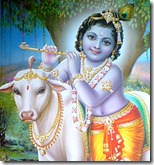 “Whenever we see any living entity we should think, ‘Here is a spirit soul.’ Anyone who can understand such a spiritual vision of life is pandita.” (Shrila Prabhupada, Raja-vidya, Ch 8 )
“Whenever we see any living entity we should think, ‘Here is a spirit soul.’ Anyone who can understand such a spiritual vision of life is pandita.” (Shrila Prabhupada, Raja-vidya, Ch 8 )Our treatment of others is directly influenced by how we identify them. If the person standing next to us is considered an enemy, we will not be forthcoming with our thoughts and emotions. When interacting with a salesperson or someone who is only interested in separating us from our money, we will be hesitant to buy what they are selling, even if it’s just advice. On the flip side, if the neighboring person is identified as a friend, someone with a common interest, we will be friendlier towards them and more open in our dealings. For the learned person, there is no such thing as the duality of like and dislike. When this mindset is applied to the vision, every life form is taken to be equal, a spirit soul just like everyone else. This proper identification can prove to be most beneficial for all parties involved.
How do we know that everyone is equal? One way is to do a study of every single life form on earth and notice how they go through growth, development, and decay cycles. We could also research how human beings and animals both eat, sleep, mate and defend, and how they have consciousness. But outward perception is limited by time and space. Our time within a specific body is not infinite; our residence is not fixed. Even the dwelling we occupy, the body, goes through so many cycles of creation and destruction. The body we had as a child is completely different from the body we have as adults. We know for a fact that once we become very old, our body will again be completely different. Yet our identity remains the same throughout, so we can deduce that whatever it is that identifies us must not be tied to the form that constantly changes.
“As the embodied soul continually passes, in this body, from boyhood to youth to old age, the soul similarly passes into another body at death. The self-realized soul is not bewildered by such a change.” (Lord Krishna, Bhagavad-gita, 2.13)
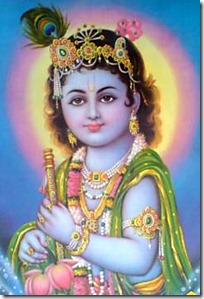 We can hopefully deduce all of this information from outward study, which is limited, or we can accept supreme knowledge from the proper authority sources. There is no better place to go for right information than the Vedas, whose most concise and complete scripture is the Bhagavad-gita. In this wonderful work, which is set on a battlefield many thousands of years ago, a bewildered soldier has a discussion with his friend, cousin and charioteer prior to the commencement of hostilities. You see the soldier doesn’t want to fight, because there are friends and family members on the opposing side. Understanding that they too are life forms, he doesn’t want to cause them any harm, especially for something as insignificant as the right to rule over a kingdom.
We can hopefully deduce all of this information from outward study, which is limited, or we can accept supreme knowledge from the proper authority sources. There is no better place to go for right information than the Vedas, whose most concise and complete scripture is the Bhagavad-gita. In this wonderful work, which is set on a battlefield many thousands of years ago, a bewildered soldier has a discussion with his friend, cousin and charioteer prior to the commencement of hostilities. You see the soldier doesn’t want to fight, because there are friends and family members on the opposing side. Understanding that they too are life forms, he doesn’t want to cause them any harm, especially for something as insignificant as the right to rule over a kingdom.Rather than rely solely on his identifications formed through sense perception, this soldier had the good sense to take instruction from a more reliable source. He was open to being convinced otherwise should the arguments move him so. He asked his charioteer, who was known to be the well-wisher of every living entity and also the greatest authority figure on knowledge, to settle his doubts about what should be done. This wonderful chariot driver, whose name was Krishna, started off His discourse with a bang, an unexpected jolt of sublime wisdom delivered without hesitation. Immediately He informed the warrior, Arjuna, that the soul is the identifiable aspect within the body. Just as the soul flows with the bodily changes from the time of youth all the way up until old age, the soul similarly passes into another body at the time of death. One who is dhira, or sober, is not bewildered by such changes.
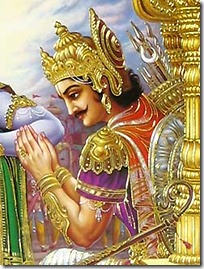 This point raised by Krishna is very important to understand. The constant shifts in the manifested world can certainly delude our consciousness. Arjuna himself was taken off the righteous path duly assigned his class because of identifications he was making with respect to the body. He was thinking that his friends and family on the other side would lose their identities if killed in a fair fight, one that their side had actually instigated. Arjuna was fighting for the Pandavas, who were the rightful heirs to a massive kingdom. The opposing side, the Kauravas, had unjustly usurped this authority and driven the Pandavas out. If Arjuna did not stand up and fight, which was his occupational duty as a warrior to do, then who would ever stand up for justice?
This point raised by Krishna is very important to understand. The constant shifts in the manifested world can certainly delude our consciousness. Arjuna himself was taken off the righteous path duly assigned his class because of identifications he was making with respect to the body. He was thinking that his friends and family on the other side would lose their identities if killed in a fair fight, one that their side had actually instigated. Arjuna was fighting for the Pandavas, who were the rightful heirs to a massive kingdom. The opposing side, the Kauravas, had unjustly usurped this authority and driven the Pandavas out. If Arjuna did not stand up and fight, which was his occupational duty as a warrior to do, then who would ever stand up for justice?Krishna then informed Arjuna that the pandita, or wise man, views everyone equally. This vision doesn’t just apply to human beings. Whether looking at a cow, dog, learned sage, fighter, laborer, or even a small child, the pandita sees the same essence of life within. As such, their vision is the most inclusive, as it does not discriminate based on outward features. The advantage of having this vision, which is the most accurate, is that one can realize that everyone else is in the same boat of suffering. If we create designations such as “friend” and “enemy” based on perceived differences in outward features, we fail to understand the purpose behind man’s association with material nature.
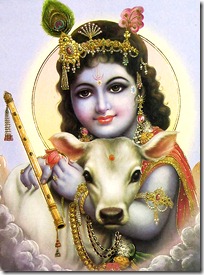 Is there not a difference between a friend and an enemy? Were not the members of the opposing army Arjuna’s enemies? Should he have treated them the same as he did the members of his own army? The equal vision of the pandita is meant to act as a starting point. Our initial identification, which should also be the most inclusive in scope, influences our initial impulses, or our behavior towards others. If I see another living entity and identify them first as being a spirit soul, my subsequent thoughts can follow along these lines. “Oh, here is another spirit soul trapped in an ever-changing body. Their original home, as well as mine, is in a place that is permanent, non-changing, blissful and conducive to knowledge. These properties are beneficial to me as well as to them, for we are both spirit souls. Since I realize that we are both equal, it is my duty to try to instill the same vision of equality in them and help them ascend back to our natural home.”
Is there not a difference between a friend and an enemy? Were not the members of the opposing army Arjuna’s enemies? Should he have treated them the same as he did the members of his own army? The equal vision of the pandita is meant to act as a starting point. Our initial identification, which should also be the most inclusive in scope, influences our initial impulses, or our behavior towards others. If I see another living entity and identify them first as being a spirit soul, my subsequent thoughts can follow along these lines. “Oh, here is another spirit soul trapped in an ever-changing body. Their original home, as well as mine, is in a place that is permanent, non-changing, blissful and conducive to knowledge. These properties are beneficial to me as well as to them, for we are both spirit souls. Since I realize that we are both equal, it is my duty to try to instill the same vision of equality in them and help them ascend back to our natural home.”With this vision a fraternal attitude is immediately adopted. As mentioned before, the soul is the object of identification within any form of life. The outward features are there to be delusional, to result in the formation of factions, castes and prejudices for those who are unaware of their real identity. From the same conversation between Arjuna and Krishna, we learn that the soul’s natural home is in the spiritual world, a transcendental realm situated far above our current one. Based on the desires for contact with changing matter, the soul is granted a body and residence in the perishable realm. When the specific form decays and runs its course of usefulness, a new form is granted. The differences in outward forms are the result of the desires of the conditioned soul and the reactions to the work he performs. Just as when we let go of an object from our hands it will fall to the ground, every single action undertaken under a false identification brings a commensurate reaction.
“Arjuna saw in that universal form unlimited mouths and unlimited eyes. It was all wondrous. The form was decorated with divine, dazzling ornaments and arrayed in many garbs. He was garlanded gloriously, and there were many scents smeared over His body. All was magnificent, all-expanding, unlimited. This was seen by Arjuna.” (Bhagavad-gita, 11.10-11)
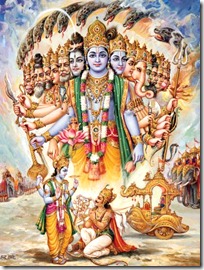 Krishna also tells Arjuna that the spirit soul who has the proper identification then understands the ultimate mission in life, that of serving God. Finally, Krishna reveals the most hidden secret, the piece of information that will help rescue the fallen souls and enable them to quickly attain a proper vision. You see the person Arjuna was accepting instruction from was none other than the Supreme Personality Himself, the origin of all spirit and life. Krishna supported His claim of divinity by showing off His universal form, the virata-rupa, to Arjuna. So awe-inspiring was this vision that Arjuna could not look at it for too long. He preferred interacting with Krishna in His two-armed form.
Krishna also tells Arjuna that the spirit soul who has the proper identification then understands the ultimate mission in life, that of serving God. Finally, Krishna reveals the most hidden secret, the piece of information that will help rescue the fallen souls and enable them to quickly attain a proper vision. You see the person Arjuna was accepting instruction from was none other than the Supreme Personality Himself, the origin of all spirit and life. Krishna supported His claim of divinity by showing off His universal form, the virata-rupa, to Arjuna. So awe-inspiring was this vision that Arjuna could not look at it for too long. He preferred interacting with Krishna in His two-armed form.Understanding that Krishna is God, or at least acknowledging that God is a merciful personality who is the object of worship, is the most important objective because it provides the person who has adopted the proper identifying system an end-goal, a purpose to their activities following a purified vision. Because everyone is equal in the spiritual sense, the ultimate destination, or ideal home, is the same for everyone. Therefore the first thing that results from acquiring the equal vision is a desire to help every living entity, irrespective of their outward appearance, reach their ideal destination, the spiritual sky where Lord Krishna and His multitude of non-different forms reside. The formula for returning to this land is quite simple. Krishna declared to Arjuna that anyone who thinks of Him at the time of death will immediately return to His land and never have to endure reincarnation again.
 So what did Arjuna do with his newly acquired information, knowledge which he took from the most authorized source? Did he go up to the opposing fighters and apprise them of their real identities and their need for going back to the spiritual land? As a member of the fighting class, Arjuna’s duty was to protect the principles of religion, which in this case called for the Pandavas to rule over the disputed kingdom. The equal vision is just the starting point, and based on the qualities of the target individual, different courses of action can be taken. For instance, we know that a tiger is a spirit soul, one who is intimately tied to God, but this doesn’t mean that we should go up to one and pet it. A tiger is a ferocious animal that lives off killing others. It has no capacity to understand spiritual instruction, nor should such an attempt to teach even be made.
So what did Arjuna do with his newly acquired information, knowledge which he took from the most authorized source? Did he go up to the opposing fighters and apprise them of their real identities and their need for going back to the spiritual land? As a member of the fighting class, Arjuna’s duty was to protect the principles of religion, which in this case called for the Pandavas to rule over the disputed kingdom. The equal vision is just the starting point, and based on the qualities of the target individual, different courses of action can be taken. For instance, we know that a tiger is a spirit soul, one who is intimately tied to God, but this doesn’t mean that we should go up to one and pet it. A tiger is a ferocious animal that lives off killing others. It has no capacity to understand spiritual instruction, nor should such an attempt to teach even be made.The equal vision, understanding that everyone else is in the same boat that I am in, brings strong feelings of compassion and kindness. But the effects of material nature should not be forgotten. The ants, trees, animals and other non-human species can be understood to be where they are because of past karma. At the same time, just because they are in a species incapable of accepting spiritual instruction and acting on it doesn’t mean that we should consider them to be inferior to us or worthy of punishment. We don’t kill our dogs and cats because they are less intelligent; so just because a cow’s flesh might be tasty doesn’t mean we should unnecessarily kill them. The cow is a mother with children just like many human beings are, so why should we systematically go on a killing spree to eat beef, especially when so many other varieties of food are available to the human being?
The material qualities continue to act on all embodied living beings, but this doesn’t preclude the person with an equal vision from instructing those willing to learn about spiritual matters. It was Arjuna’s duty to fight, as the time and circumstance did not call for spiritual instruction being imparted to the opposing side, who were all spirit souls just like Arjuna. The equal vision makes it much easier to abide by our prescribed duties borne of our order. If we are suited for performing labor, running a business, administering a community, protecting the innocent, or teaching others about the highest knowledge, we should perform our duties while simultaneously maintaining the equal vision.
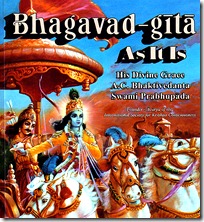 With respect to the most important instruction found in the conversation between Krishna and Arjuna, a discourse which is famously chronicled in the book called the Bhagavad-gita, the way to think of Krishna constantly is to take to devotional service, or bhakti-yoga. Just as the spirit soul is the identifiable aspect within every form of life, the engagement of divine love, or bhakti, is the foremost occupational duty, or dharma, for spirit. While the body types assumed have commensurate occupational duties as they relate to material activities, the penchant for loving God never leaves the soul. In every form of life there is the desire to serve God, but only with a developed consciousness can that service be acted upon fully. Thus we see that the true benefit of acquiring the equal vision of the pandita is the ability to apprise others of the essence of divine love and the benefits that come from practicing it.
With respect to the most important instruction found in the conversation between Krishna and Arjuna, a discourse which is famously chronicled in the book called the Bhagavad-gita, the way to think of Krishna constantly is to take to devotional service, or bhakti-yoga. Just as the spirit soul is the identifiable aspect within every form of life, the engagement of divine love, or bhakti, is the foremost occupational duty, or dharma, for spirit. While the body types assumed have commensurate occupational duties as they relate to material activities, the penchant for loving God never leaves the soul. In every form of life there is the desire to serve God, but only with a developed consciousness can that service be acted upon fully. Thus we see that the true benefit of acquiring the equal vision of the pandita is the ability to apprise others of the essence of divine love and the benefits that come from practicing it.The pandita, understanding the true nature of spirit, regularly chants the holy names found in the maha-mantra, “Hare Krishna Hare Krishna, Krishna Krishna, Hare Hare, Hare Rama Hare Rama, Rama Rama, Hare Hare”, and induces others to take up the same chanting process. Unlike occupational duties tied to the specific body type assumed by the soul, bhakti is not reserved for any specific species. Even a young child can chant Hare Krishna and come into contact with the Lord. When we apply the equal vision to the surrounding world and understand that every other living entity is the same as us, we can understand that their ideal home is in the spiritual land where Krishna resides, a place where the glories of Godhead are sung on a regular basis and the flawed identifications borne of material contact are completely absent.
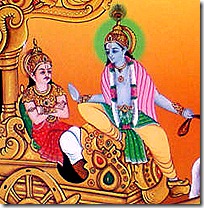 The vision of the pandita starts with the proper identification. “Here is a spirit soul. Here is a person who is intimately tied to Krishna’s service.” Even if we see that another’s body type precludes them from understanding their true nature and the beauty of divine love, we can still maintain our devotional attitude and keep our service going. Arjuna was a member of the warrior caste temporarily deluded by attachments formed off of false identifications, but when he needed help, the original spiritual master, Shri Krishna, was there to properly guide him. The confidential knowledge of the Gita was revealed to Arjuna not because he was a learned scholar or a recognized pandita. He was Krishna’s friend who harbored no ill-will towards the Lord. Similarly, those who are pure hearted and non-envious of God can understand the sublime instructions of the Gita, the transcendental sound vibrations emanating from the lotus mouths of the panidtas ever engaged in devotional service, and the need for returning back home, back to Godhead. The equal vision acquired through hearing from authorized sources allows us to properly identify all forms of life and also speak to those who are interested about the meaning of life and the purpose to our existence. With this clarity in vision and purpose, much of the hesitation that so debilitates us goes away, allowing for life to continue peacefully, with the consciousness focused on that wonderful teacher who so kindly took to instructing Arjuna and the world on that fateful day on the battlefield of Kurukshetra.
The vision of the pandita starts with the proper identification. “Here is a spirit soul. Here is a person who is intimately tied to Krishna’s service.” Even if we see that another’s body type precludes them from understanding their true nature and the beauty of divine love, we can still maintain our devotional attitude and keep our service going. Arjuna was a member of the warrior caste temporarily deluded by attachments formed off of false identifications, but when he needed help, the original spiritual master, Shri Krishna, was there to properly guide him. The confidential knowledge of the Gita was revealed to Arjuna not because he was a learned scholar or a recognized pandita. He was Krishna’s friend who harbored no ill-will towards the Lord. Similarly, those who are pure hearted and non-envious of God can understand the sublime instructions of the Gita, the transcendental sound vibrations emanating from the lotus mouths of the panidtas ever engaged in devotional service, and the need for returning back home, back to Godhead. The equal vision acquired through hearing from authorized sources allows us to properly identify all forms of life and also speak to those who are interested about the meaning of life and the purpose to our existence. With this clarity in vision and purpose, much of the hesitation that so debilitates us goes away, allowing for life to continue peacefully, with the consciousness focused on that wonderful teacher who so kindly took to instructing Arjuna and the world on that fateful day on the battlefield of Kurukshetra.
No comments:
Post a Comment